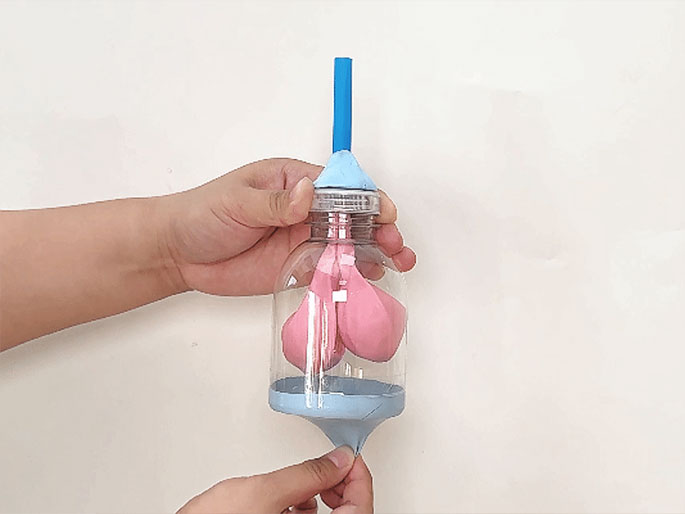DIY Respiratory System
Stem Activities

Ages: 6-8

Less than 30 minutes

Grownup needed
Breathing is fundamental to life, and understanding the science behind it enhances our appreciation and respect for our bodies. Create a simple DIY lung model and explore the fascinating process of breathing with your child!
Materials Needed
- Plastic bottle
- Tape
- Modelling clay
- 3 balloons
- Scissors
- 2 thin straws
- 1 thick straw
- Ruler
Step-by-step tutorial
Using scissors, cut 8cm sections from each of the three straws.
Insert the two thin straw sections into the thick straw.
Secure the connection points between the thin and thick straws using tape.
Attach balloons to each thin straw and secure them firmly with tape.
Next, cut off the bottom of the plastic bottle using scissors. Ask an adult for help if you find this step difficult.
Take one balloon and cut it in half with scissors, keeping the neck end for later use.
Stretch the cut balloon neck over the bottom of the plastic bottle.
Secure the balloon to the bottle using tape.
Using scissors, make a small hole in the centre of the bottle cap that's just large enough for the straw.
Thread the thick straw up through the hole in the bottle cap from below.
Use modelling clay to seal the connection between the bottle cap and thick straw. Ensure it's completely airtight.
Secure the prepared cap onto the plastic bottle.
Now, pull the balloon at the bottom of the bottle. Observe what happens to the balloons inside the bottle.

The Science Behind It:
This simple model helps us understand the basic principles of breathing.
Inhaling: When we pull the balloon simulating the diaphragm, the pressure inside the plastic bottle decreases below atmospheric pressure, causing the balloons (lungs) to expand.
Exhaling: Releasing the diaphragm balloon simulates the relaxation of the diaphragm, reducing the chest cavity volume and causing the balloons (lungs) to contract. During each deep breath, the intricate cooperation between our diaphragm and chest cavity allows air to flow in and out of our lungs, sustaining life.

 STEM Activities
STEM Activities Artistic Adventures
Artistic Adventures Playful Learning
Playful Learning The Recipe Repository
The Recipe Repository  Nature Explorations
Nature Explorations












